Preparation of Cement Clinker from Geopolymer-Based Wastes
Abstract
:1. Introduction
2. Materials and Methods
2.1. Materials, Equipment, and Methods
2.2. Preparation of Geopolymer-Based Materials
2.3. Clinker Preparation
3. Results and Discussion
3.1. Geopolymer-Based Raw Materials
3.2. Cement Clinkers
- (i)
- Formation of intermediate reactive oxides by dehydration/dehydroxylation and decomposition of clay at temperatures lower than 950 °C;
- (ii)
- Formation of metal oxides (i.e., CaO, MgO) by carbonate decomposition at 550–1000 °C;
- (iii)
- Crystallization of the calcium aluminate CA (CaO·Al2O3) and ferroaluminate C2AF (2CaO·Al2O3·Fe2O3). Then, conversion of CaO, CS, CA, and Fe2O3 into the ferrite C4AF, tricalcium aluminate C3A, and belite C2S phases. These reactions occur in the temperature range of 550–1280 °C, according to the following Equations:CaO·Al2O3 + 2CaO → 3CaO·Al2O3CaO·Al2O3 + 3CaO + Fe2O3→ 4CaO·Al2O3·Fe2O3CaO·SiO2 + CaO → 2CaO·SiO2
- (iv)
- Formation of the alite phase C3S by the chemical reaction of free CaO with C2S; melting of C4AF attemperatures higher than 1280 °C. The molten C4AF medium promotes the growth of the pre-existing C2S and C3S phases in the reaction mixture at this temperature range.
4. Conclusions
Author Contributions
Funding
Institutional Review Board Statement
Informed Consent Statement
Conflicts of Interest
References
- Davidovits, J. Properties of Geopolymer Cements. In Proceedings of the 1st International Conference on Alkaline Cements and Concretes, Scientific Research Institute On Binders and Materials, Kiev, Ukraine, 1994; pp. 131–149. Available online: http://www.geopolymer.org/wp-content/uploads/KIEV.pdf (accessed on 28 September 2021).
- Provis, J.L.; Van Deventer, J.S.J. Geopolymers: Structures, Processing, Properties and Industrial Applications; Elsevier: Amsterdam, The Netherlands, 2009; ISBN 9781845694494. [Google Scholar]
- Fazli, H.; Yan, D.; Zhang, Y.; Zeng, Q. Effect of Size of Coarse Aggregate on Mechanical Properties of Metakaolin-Based Geopolymer Concrete and Ordinary Concrete. Materials 2021, 14, 3316. [Google Scholar] [CrossRef]
- Jiang, C.; Wang, A.; Bao, X.; Ni, T.; Ling, J. A review on geopolymer in potential coating application: Materials, preparation and basic properties. J. Build. Eng. 2020, 32, 101734. [Google Scholar] [CrossRef]
- Ngouloure, Z.N.M.; Nait-Ali, B.; Zekeng, S.; Kamseu, E.; Melo, U.C.; Smith, D.; Leonelli, C. Recycled natural wastes in metakaolin based porous geopolymers for insulating applications. J. Build. Eng. 2015, 3, 58–69. [Google Scholar] [CrossRef] [Green Version]
- Prochon, P.; Zhao, Z.; Courard, L.; Piotrowski, T.; Michel, F.; Garbacz, A. Influence of Activators on Mechanical Properties of Modified Fly Ash Based Geopolymer Mortars. Materials 2020, 13, 1033. [Google Scholar] [CrossRef] [Green Version]
- Singh, N.B. Fly Ash-Based Geopolymer Binder: A Future Construction Material. Minerals 2018, 8, 299. [Google Scholar] [CrossRef] [Green Version]
- Hattaf, R.; Aboulayt, A.; Samdi, A.; Lahlou, N.; Ouazzani Touhami, M.; Gomina, M.; Moussa, R. Reusing Geopolymer Waste from Matrices Based on Metakaolin or Fly Ash for the Manufacture of New Binder Geopolymeric Matrices. Sustainability 2021, 13, 8070. [Google Scholar] [CrossRef]
- Akbarnezhad, A.; Huan, M.; Mesgari, S.; Castel, A. Recycling of geopolymer concrete. Constr. Build. Mater. 2015, 101, 152–158. [Google Scholar] [CrossRef]
- Zhu, P.; Hua, M.; Liu, H.; Wang, X.; Chen, C. Interfacial evaluation of geopolymer mortar prepared with recycled geopolymer fine aggregates. Constr. Build. Mater. 2020, 259, 119849. [Google Scholar] [CrossRef]
- Gharzouni, A.; Vidal, L.; Essaidi, N.; Joussein, E.; Rossignol, S. Recycling of geopolymer waste: Influence on geopolymer formation and mechanical properties. Mater. Des. 2016, 94, 221–229. [Google Scholar] [CrossRef]
- Buruberri, L.H.; Seabra, M.P.; Labrincha, J.A. Preparation of clinker from paper pulp industry wastes. J. Hazard. Mater. 2015, 286, 252–260. [Google Scholar] [CrossRef] [PubMed]
- Samet, B.; Mnif, T.; Chaabouni, M. Use of a kaolinitic clay as a pozzolanic material for cements: Formulation of blended cement. Cem. Concr. Compos. 2007, 29, 741–749. [Google Scholar] [CrossRef]
- Wan, Q.; Rao, F.; Song, S. Reexamining calcination of kaolinite for the synthesis of metakaolin geopolymers—Roles of dehydroxylation and recrystallization. J. Non. Cryst. Solids 2017, 460, 74–80. [Google Scholar] [CrossRef]
- Xu, G.; Zhong, J.; Shi, X. Influence of graphene oxide in a chemically activated fly ash. Fuel 2018, 226, 644–657. [Google Scholar] [CrossRef]
- Cai, J.; Li, X.; Tan, J.; Vandevyvere, B. Thermal and compressive behaviors of fly ash and metakaolin-based geopolymer. J. Build. Eng. 2020, 30, 101307. [Google Scholar] [CrossRef]
- Gao, K.; Lin, K.L.; Wang, D.; Hwang, C.L.; Shiu, H.S.; Chang, Y.M.; Cheng, T.W. Effects SiO2/Na2O molar ratio on mechanical properties and the microstructure of nano-SiO2 metakaolin-based geopolymers. Constr. Build. Mater. 2014, 53, 503–510. [Google Scholar] [CrossRef]
- Cho, Y.K.; Yoo, S.W.; Jung, S.H.; Lee, K.M.; Kwon, S.J. Effect of Na2O content, SiO2/Na2O molar ratio, and curing conditions on the compressive strength of FA-based geopolymer. Constr. Build. Mater. 2017, 145, 253–260. [Google Scholar] [CrossRef]
- Yuan, J.; He, P.; Jia, D.; Yang, C.; Zhang, Y.; Yan, S.; Yang, Z.; Duan, X.; Wang, S.; Zhou, Y. Effect of curing temperature and SiO2/K2O molar ratio on the performance of metakaolin-based geopolymers. Ceram. Int. 2016, 42, 16184–16190. [Google Scholar] [CrossRef]
- Zidi, Z.; Ltifi, M.; Zafar, I. Synthesis and attributes of nano-SiO2 local metakaolin based-geopolymer. J. Build. Eng. 2021, 33, 101586. [Google Scholar] [CrossRef]
- Jiang, X.; Zhang, Y.; Xiao, R.; Polaczyk, P.; Zhang, M.; Hu, W.; Bai, Y.; Huang, B. A comparative study on geopolymers synthesized by different classes of fly ash after exposure to elevated temperatures. J. Clean. Prod. 2020, 270, 122500. [Google Scholar] [CrossRef]
- Durak, U.; İlkentapar, S.; Karahan, O.; Uzal, B.; Atiş, C.D. A new parameter influencing the reaction kinetics and properties of fly ash based geopolymers: A pre-rest period before heat curing. J. Build. Eng. 2020, 35, 102023. [Google Scholar] [CrossRef]
- Rodríguez, E.D.; Bernal, S.A.; Provis, J.L.; Paya, J.; Monzo, J.M.; Borrachero, M.V. Effect of nanosilica-based activators on the performance of an alkali-activated fly ash binder. Cem. Concr. Compos. 2013, 35, 1–11. [Google Scholar] [CrossRef]
- Hosan, A.; Haque, S.; Shaikh, F. Compressive behaviour of sodium and potassium activators synthetized fly ash geopolymer at elevated temperatures: A comparative study. J. Build. Eng. 2016, 8, 123–130. [Google Scholar] [CrossRef]
- Chindaprasirt, P.; Rattanasak, U.; Taebuanhuad, S. Resistance to acid and sulfate solutions of microwave-assisted high calcium fly ash geopolymer. Mater. Struct. Constr. 2013, 46, 375–381. [Google Scholar] [CrossRef]
- Nettleship, I.; Slavick, K.G.; Kim, Y.J.; Kriven, W.M. Phase Transformations in Dicalcium Silicate: I, Fabrication and Phase Stability of Fine-Grained β Phase. J. Am. Ceram. Soc. 1992, 75, 2400–2406. [Google Scholar] [CrossRef]
- González-Velasco, J.R.; Ferret, R.; López-Fonseca, R.; Gutiérrez-Ortiz, M.A. Influence of particle size distribution of precursor oxides on the synthesis of cordierite by solid-state reaction. Powder Technol. 2005, 153, 34–42. [Google Scholar] [CrossRef]
- Chatterjee, A.K. Chemico-Mineralogical characteristics of raw materials. In Advances in Cement Technology; Pergamon Press: Oxford, UK, 1983; pp. 39–68. [Google Scholar]
- Shi, Z.; Leemann, A.; Rentsch, D.; Lothenbach, B. Synthesis of alkali-silica reaction product structurally identical to that formed in field concrete. Mater. Des. 2020, 190, 108562. [Google Scholar] [CrossRef]
- ASTM C 150-97—Standard Specification for Portland Cement; ASTM International: West Conshohocken, PA, USA, 1997.
- Papamarkou, S.; Christopoulos, D.; Tsakiridis, P.E.; Bartzas, G.; Tsakalakis, K. Vitrified medical wastes bottom ash in cement clinkerization. Microstructural, hydration and leaching characteristics. Sci. Total. Environ. 2018, 635, 705–715. [Google Scholar] [CrossRef]
- Young, G.; Yang, M. Preparation and characterization of Portland cement clinker from iron ore tailings. Constr. Build. Mater. 2019, 197, 152–156. [Google Scholar] [CrossRef]
- Liu, X.; Jin, J.; Wu, W.; Herz, F. A novel support vector machine ensemble model for estimation of free lime content in cement clinkers. ISA Trans. 2020, 99, 479–487. [Google Scholar] [CrossRef]
- Cuesta, A.; Losilla, E.R.; Aranda, M.A.G.; Sanz, J.; De La Torre, Á.G. Reactive belite stabilization mechanisms by boron-bearing dopants. Cem. Concr. Res. 2012, 42, 598–606. [Google Scholar] [CrossRef]
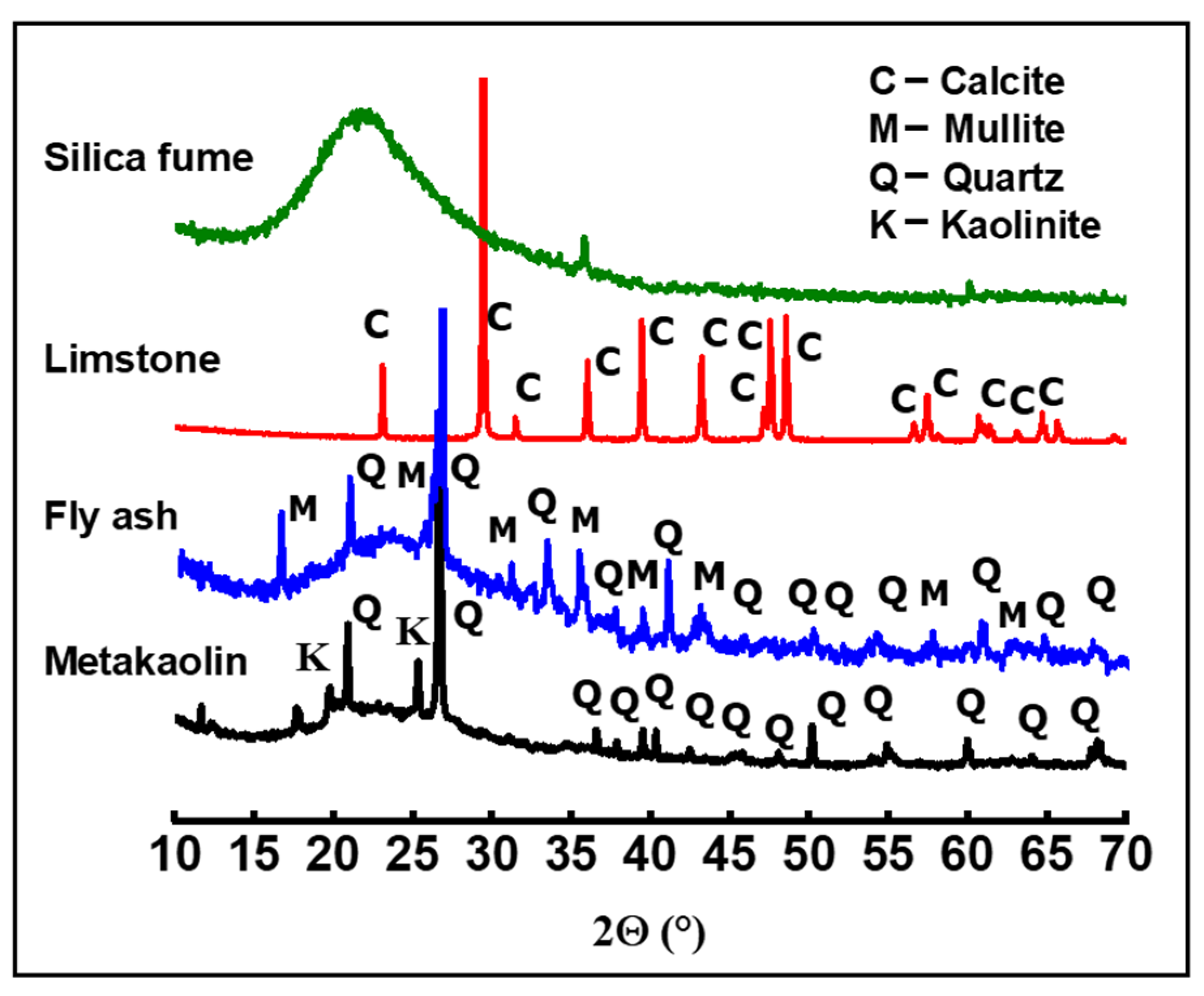
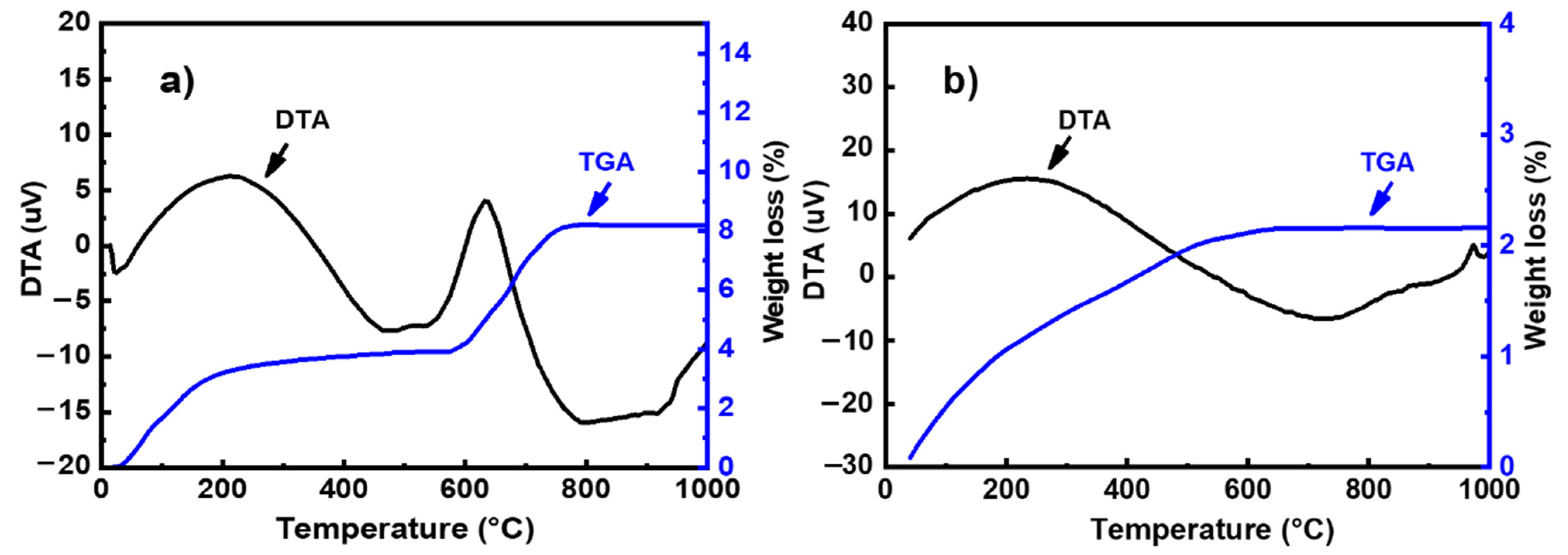


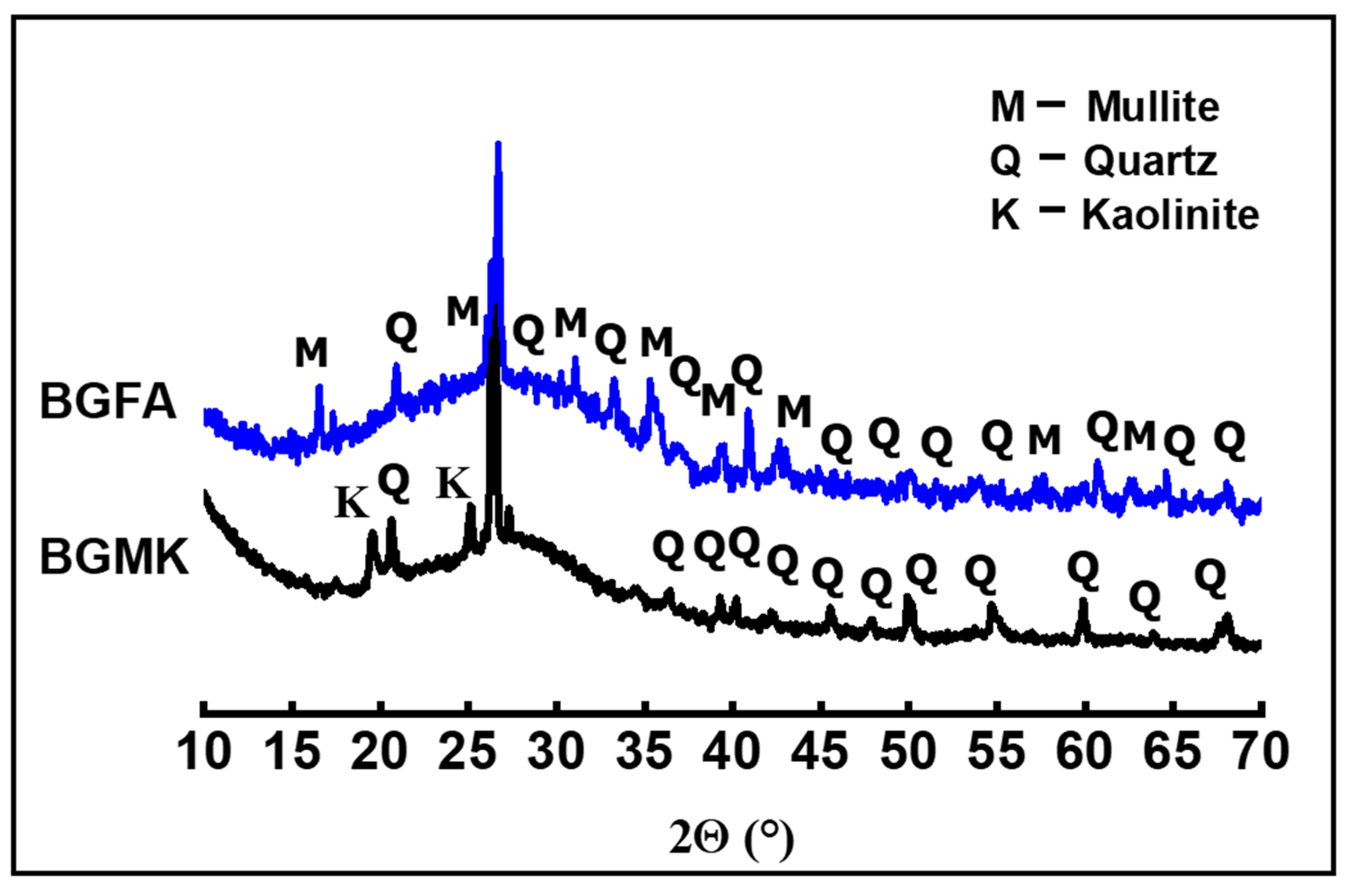

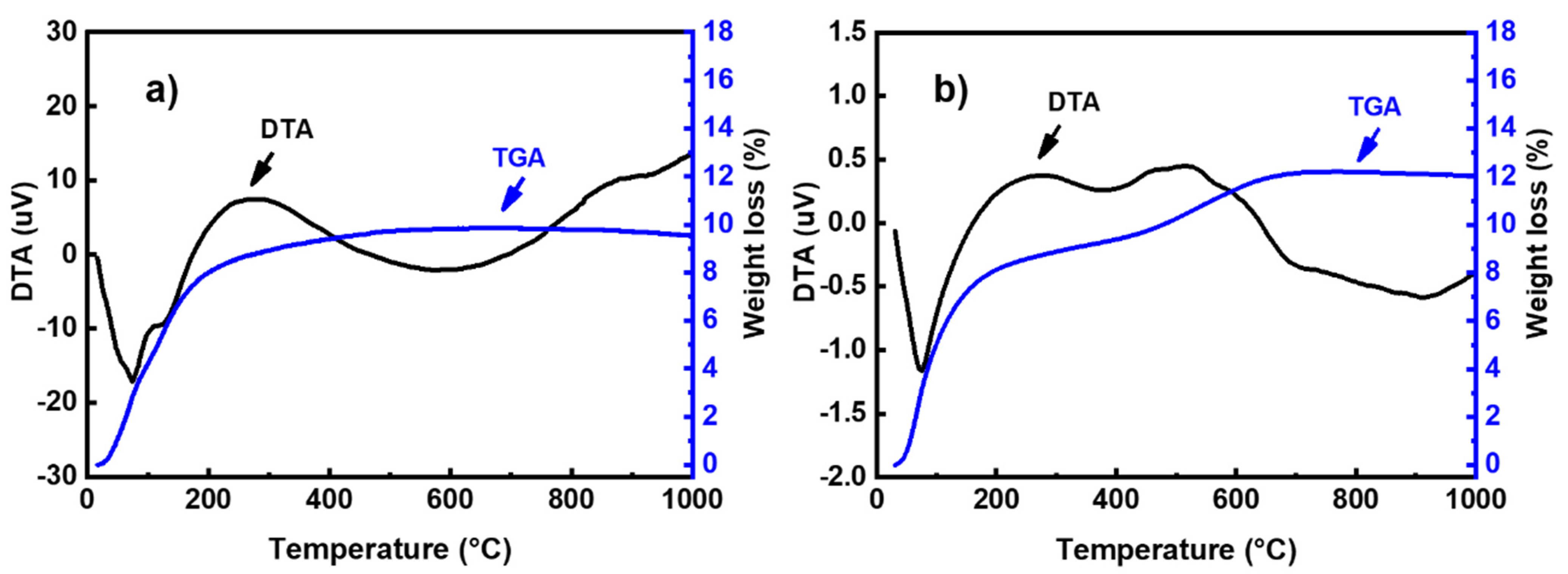

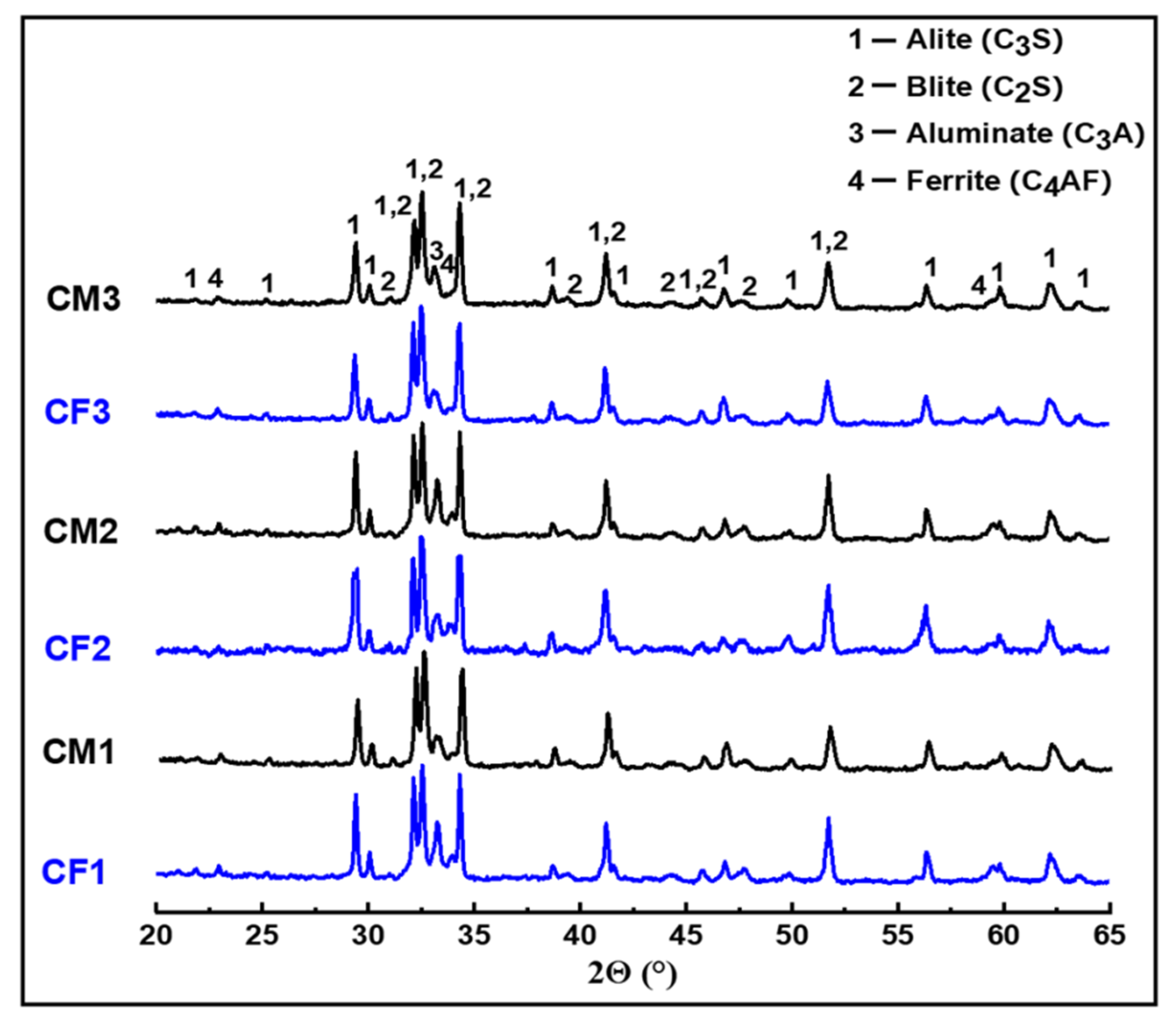
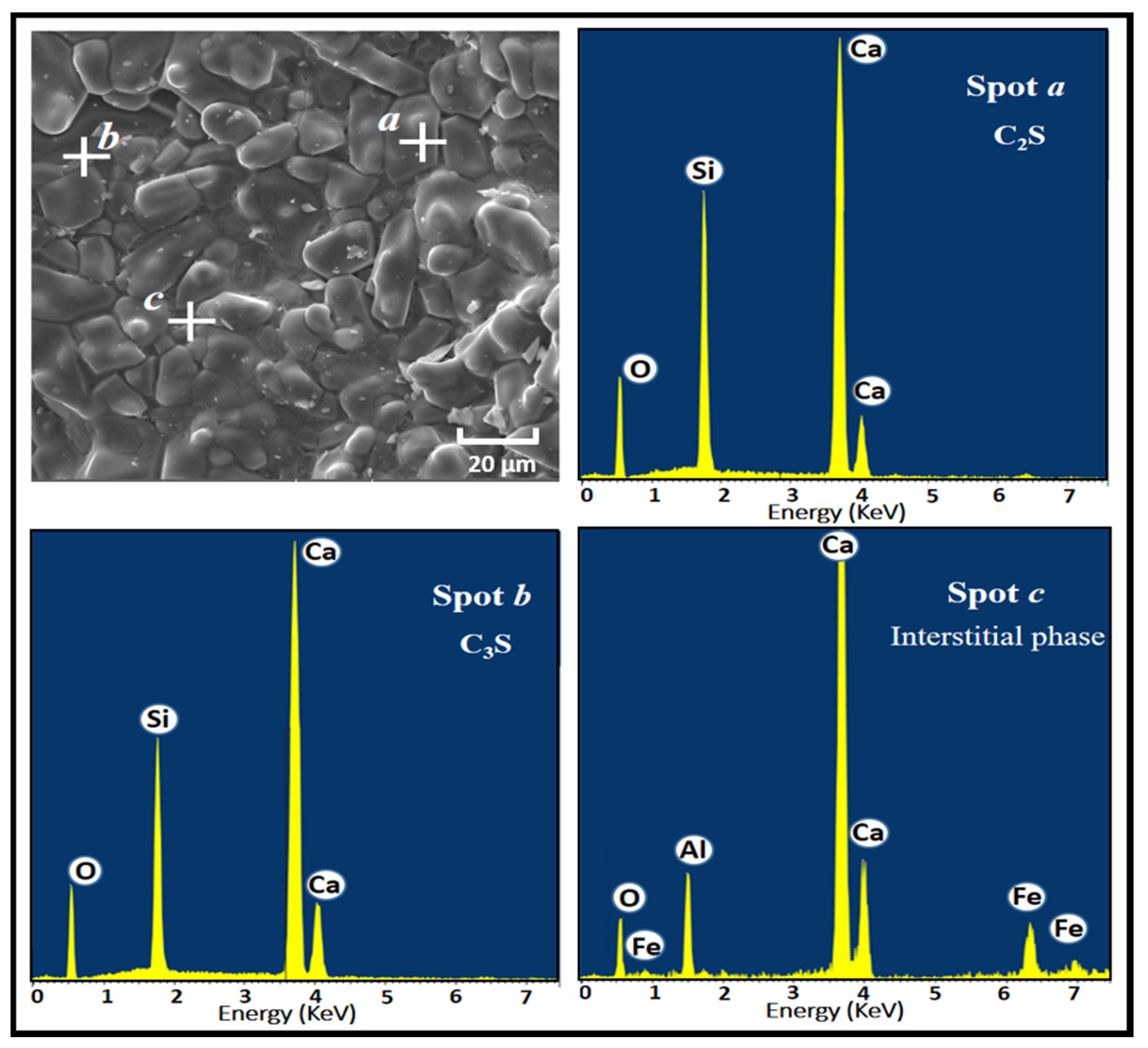
| Raw Materials | Oxides (wt%) | |||||||||
|---|---|---|---|---|---|---|---|---|---|---|
| SiO2 | Al2O3 | Fe2O3 | CaO | MgO | SO3 | Na2O | K2O | P2O5 | LOI | |
| Metakaolin | 57.38 | 37.11 | 1.41 | 0.43 | 0.36 | 0.19 | 0.18 | 0.81 | 0.06 | 2.08 |
| Fly Ash | 51.48 | 22.57 | 5.86 | 4.79 | 2.21 | 0.51 | 0.62 | 1.10 | 0.86 | 10.01 |
| Limestone | 0.21 | 0.08 | 0.02 | 56.13 | 0.26 | 0.20 | 0.01 | 0.01 | 0.01 | 43.08 |
| Silica Fume | 93.86 | 0.27 | 0.04 | 0.96 | 1.28 | 0.20 | 0.18 | 0.30 | 0.09 | 2.82 |
| Sand | 97.81 | 0.45 | 0.06 | 0.39 | 0.08 | 0.22 | 0.10 | 0.24 | 0.02 | 0.63 |
| Raw Materials | Formulations (wt%) | |||||
|---|---|---|---|---|---|---|
| M1 | F1 | M2 | F2 | M3 | F3 | |
| Limestone | 76.86 | 74.01 | 78.35 | 76.83 | 78.63 | 76.93 |
| Metakaolin | - | - | 6.76 | - | 6.50 | - |
| Fly Ash | - | - | - | 12.17 | - | 12.19 |
| BGMK | 15.53 | - | 3.74 | - | - | - |
| BGFA | - | 21.08 | - | 2.75 | - | - |
| MGMK | - | - | - | - | 13.20 | |
| MGFA | - | - | - | - | 10.04 | |
| Silica fume | 5.82 | 4.30 | 9.49 | 7.41 | - | - |
| Fe2O3 | 1.79 | 0.60 | 1.66 | 0.85 | 1.67 | 0.85 |
| Raw Materials | Oxides (wt%) | |||||||||
|---|---|---|---|---|---|---|---|---|---|---|
| SiO2 | Al2O3 | Fe2O3 | CaO | MgO | SO3 | Na2O | K2O | P2O5 | LOI | |
| BGFA | 47.05 | 17.34 | 5.49 | 5.45 | 2.12 | 0.55 | 6.64 | 1.66 | 0.58 | 13.11 |
| BGMK | 54.42 | 25.35 | 1.09 | 1.21 | 0.28 | 0.31 | 8.06 | 0.68 | 0.10 | 8.49 |
| MGFA | 84.02 | 5.04 | 1.53 | 1.77 | 0.64 | 0.31 | 1.88 | 0.63 | 0.17 | 4.02 |
| MGMK | 84.79 | 7.92 | 0.37 | 0.64 | 0.14 | 0.25 | 2.49 | 0.37 | 0.04 | 2.99 |
| Portland Cement Clinker | Oxides (wt%) | |||||||||
|---|---|---|---|---|---|---|---|---|---|---|
| SiO2 | Al2O3 | Fe2O3 | CaO | MgO | SO3 | Na2O | K2O | P2O5 | LOI | |
| CM1 | 21.42 | 6.10 | 2.97 | 65.95 | 0.49 | 0.32 | 1.88 | 0.19 | 0.04 | 0.64 |
| CF1 | 21.48 | 5.66 | 2.64 | 65.25 | 1.06 | 0.42 | 2.15 | 0.57 | 0.20 | 0.57 |
| CM2 | 22.76 | 5.38 | 2.72 | 66.98 | 0.55 | 0.30 | 0.48 | 0.16 | 0.03 | 0.63 |
| CF2 | 22.41 | 5.19 | 2.66 | 67.00 | 0.95 | 0.37 | 0.38 | 0.30 | 0.20 | 0.52 |
| CM3 | 22.86 | 5.32 | 2.74 | 67.13 | 0.38 | 0.31 | 0.48 | 0.16 | 0.02 | 0.62 |
| CF3 | 22.70 | 5.04 | 2.58 | 67.05 | 0.81 | 0.38 | 0.38 | 0.30 | 0.19 | 0.58 |
| Mineralogical Phases (%) | Portland Cement Clinker | ASTM C 150-97 | |||||
|---|---|---|---|---|---|---|---|
| CM1 | CF1 | CM2 | CF2 | CM3 | CF3 | ||
| C3S | 55.79 | 55.47 | 54.75 | 58.75 | 54.8 | 57.70 | 50–70 |
| C2S | 19.65 | 20.05 | 24.27 | 20.25 | 24.5 | 21.88 | 15–35 |
| C3A | 11.15 | 10.53 | 9.66 | 9.24 | 9.46 | 8.99 | 5–12 |
| C4AF | 9.02 | 8.04 | 8.27 | 8.09 | 8.32 | 7.84 | 5–15 |
| Quality Indexes | |||||||
| SR (%) | 2.36 | 2.59 | 2.81 | 2.86 | 2.84 | 2.98 | 2.0–3.7 |
| AR (%) | 2.06 | 2.14 | 1.98 | 1.95 | 1.94 | 1.95 | 1.0–4.0 |
| LSF (%) | 94 | 93 | 92 | 93 | 92 | 92 | 92–98 |
| Na2Oeq (wt %)) | 2.01 | 2.52 | 0.59 | 0.58 | 0.59 | 0.58 | 0.6 |
| CaOf (wt %)) | 1.12 | 1.23 | 1.18 | 1.23 | 1.25 | 1.26 | 0.5–1.5 |
Publisher’s Note: MDPI stays neutral with regard to jurisdictional claims in published maps and institutional affiliations. |
© 2021 by the authors. Licensee MDPI, Basel, Switzerland. This article is an open access article distributed under the terms and conditions of the Creative Commons Attribution (CC BY) license (https://creativecommons.org/licenses/by/4.0/).
Share and Cite
Hattaf, R.; Benchikhi, M.; Azzouzi, A.; El Ouatib, R.; Gomina, M.; Samdi, A.; Moussa, R. Preparation of Cement Clinker from Geopolymer-Based Wastes. Materials 2021, 14, 6534. https://doi.org/10.3390/ma14216534
Hattaf R, Benchikhi M, Azzouzi A, El Ouatib R, Gomina M, Samdi A, Moussa R. Preparation of Cement Clinker from Geopolymer-Based Wastes. Materials. 2021; 14(21):6534. https://doi.org/10.3390/ma14216534
Chicago/Turabian StyleHattaf, Rabii, Mohamed Benchikhi, Abdessamad Azzouzi, Rachida El Ouatib, Moussa Gomina, Azzeddine Samdi, and Redouane Moussa. 2021. "Preparation of Cement Clinker from Geopolymer-Based Wastes" Materials 14, no. 21: 6534. https://doi.org/10.3390/ma14216534





